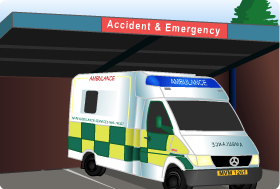
At 10.45 they arrive at the ED and take him straight into resus where the medical team are waiting for him.
The medical team confirm the time of onset with the paramedics and phone Steve to check that Iain was perfectly well prior to the 3rd hole.
They phone Iain’s wife who confirms that he is on Apixaban, and took his tablets at 8am after breakfast.
They carry out a rapid neurological assessment based on the NIHSS to confirm the diagnosis of a left hemisphere stroke.
Enter Iain’s NIHSS score based on the finding on his neurological examination described below.
Iain is alert, but does not follow any commands and cannot say the month or his age. He has a right visual field defect in both eyes, no movement in right arm or leg and does not respond to painful stimulus on the right arm and leg.
See the NIH Stroke Scale:
NIHSS Quiz, select Yes or No for each of the statements below.
NIHSS Quiz
NIHSS provides a standardised way (a common language) for describing stroke deficits and severity – Yes
Recertification involves nine cases (1 observed, 2 non-scoring and 6 test cases) – Yes
Recertification is recommended every two years for stroke clinicians – Yes
Item 1a (alertness) is the only item which can be rescored having moved on to the next item – Yes
When assessing 1b (age, month) only the first response is scored but Date of Birth is not acceptable – Yes
When assessing understanding (1c) one should not use gesture or mime to get patient to close eyes and make a fist – No
When assessing gaze (Item 2) it is important to check vertical eye movements as well as horizontal ones – No
Visual fields should be assessed in each eye separately, ideally by counting fingers in each quadrant – Yes
A complete lower motor neurone VIIth will score 3 on Item 4 (facial weakness) – Yes
The arm and leg should both be held up for 10 seconds – No
A patient with an isolated hand weakness will have an NIHSS of 1 – No
Best Language can be scored based on assessment during preceding 8 items but use testing cards if uncertain – Yes
Left and right hemisphere strokes have similar total scores – No
An NIHSS ≥ 6 is often used to decide if patient has a severe enough stroke to warrant thrombectomy – Yes


